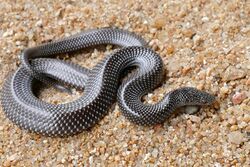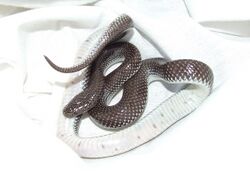Biology:Cape wolf snake
| Cape wolf snake | |
|---|---|

| |
| At Lower Sabie, southern Kruger National Park | |

| |
| Ventral aspect on an individual from Pretoria, Gauteng | |
| Scientific classification | |
| Domain: | Eukaryota |
| Kingdom: | Animalia |
| Phylum: | Chordata |
| Class: | Reptilia |
| Order: | Squamata |
| Suborder: | Serpentes |
| Family: | Lamprophiidae |
| Genus: | Lycophidion |
| Species: | L. capense
|
| Binomial name | |
| Lycophidion capense (A. Smith, 1831)[2]
| |
| <mapframe height="200" frameless="1" width="300">{"properties":{"stroke-width":6,"stroke":"#ff0000","title":"Cape wolf snake"},"type":"ExternalData","title":"Cape wolf snake range.map","service":"page"}</mapframe> | |
| IUCN range
Extant (resident)
| |
| Synonyms | |
| |
The Cape wolf snake (Lycophidion capense) is a species of oviparous,[2][3] nonvenomous snake which occurs over a wide area of Southern, Central, and East Africa.[2][4] Though docile and harmless, it may be confused with the very venomous stiletto snake.[5]
Subspecies
The species contains three subspecies, including the nominotypical subspecies, L. c. capense:[2]
- Lycophidion capense capense (A. Smith, 1831)
- Lycophidion capense jacksoni (Boulenger, 1893)
- Lycophidion capense loveridgei Laurent, 1968
Nota bene: A trinomial authority in parentheses indicates that the subspecies was originally described in a genus other than Lycophidion.
Description
Adults regularly reach 40 cm in length,[5] but some grow to 64 cm. It has a flattened, tapering head and marbled eye. The brown or black lateral and dorsal scales are tipped white,[6] while the ventral scales are all-white. Long recurved fangs are present on the upper as well as lower jaws,[5] for which they are named.
Diet and behaviour
They are widely distributed but prefer damp locations,[5] with lowland forest and fynbos being preferred habitats. They feed mostly on geckos and skinks which they bite and kill by constriction.[3] They are believed to reach an age of 15 to 20 years.[6]
References
- ↑ Howell, K.; Msuya, C.A.; Ngalason, W.; Baha El Din, S. (2021). "Lycophidion capense". IUCN Red List of Threatened Species 2021: e.T183201A1733864. doi:10.2305/IUCN.UK.2021-2.RLTS.T183201A1733864.en. https://www.iucnredlist.org/species/183201/1733864. Retrieved 23 July 2023.
- ↑ 2.0 2.1 2.2 2.3 2.4 Lycophidion capense at the Reptarium.cz Reptile Database. Accessed 17 March 2021.
- ↑ 3.0 3.1 Carruthers, Vincent (2005). The Wildlife of Southern Africa: A Field Guide to the Animal and Plants of the Region. Cape Town: Struik Publishers. pp. 92. ISBN 1-86872-451-4.
- ↑ "Lycophidion capense (Smith, 1831)". Species. GBIF. http://www.gbif.org/species/2457770.
- ↑ 5.0 5.1 5.2 5.3 "This is a Wolf... snake". Bionerds.co.za. https://www.facebook.com/bionerds.co.za/photos/a.1761360214188023.1073741828.1761354944188550/2048850788772296/?type=3&theater.
- ↑ 6.0 6.1 "Lycophidion capense (Common wolf snake, Cape wolf snake)". iziko museums. http://www.biodiversityexplorer.org/reptiles/squamata/serpentes/colubridae/lycophidion_capense.htm.
Further reading
- Boulenger GA. 1893. Catalogue of the Snakes in the British Museum (Natural History). Volume I., Containing the Families ... Colubridæ Aglyphæ, part. London: Trustees of the British Museum (Natural History). (Taylor and Francis, printers). xiii + 448 pp. + Plates I-XXVIII. (Lycophidium capense, pp. 339–340; Lycophidium jacksoni, new species, p. 340 + Plate XXI, figure 3).
- Branch, Bill. 2004. Field Guide to Snakes and other Reptiles of Southern Africa. Third Revised edition, Second impression. Sanibel Island, Florida: Ralph Curtis Books. 399 pp. ISBN:0-88359-042-5. (Lycophidion capense, p. 76 + Plate 36).
- Smith A. 1831. "Contributions to the Natural History of South Africa, &c". South African Quarterly Journal 1 (5): 9-24. (Lycodon capensis, new species, p. 18). (in Latin and English).
Wikidata ☰ Q2411819 entry
 |


